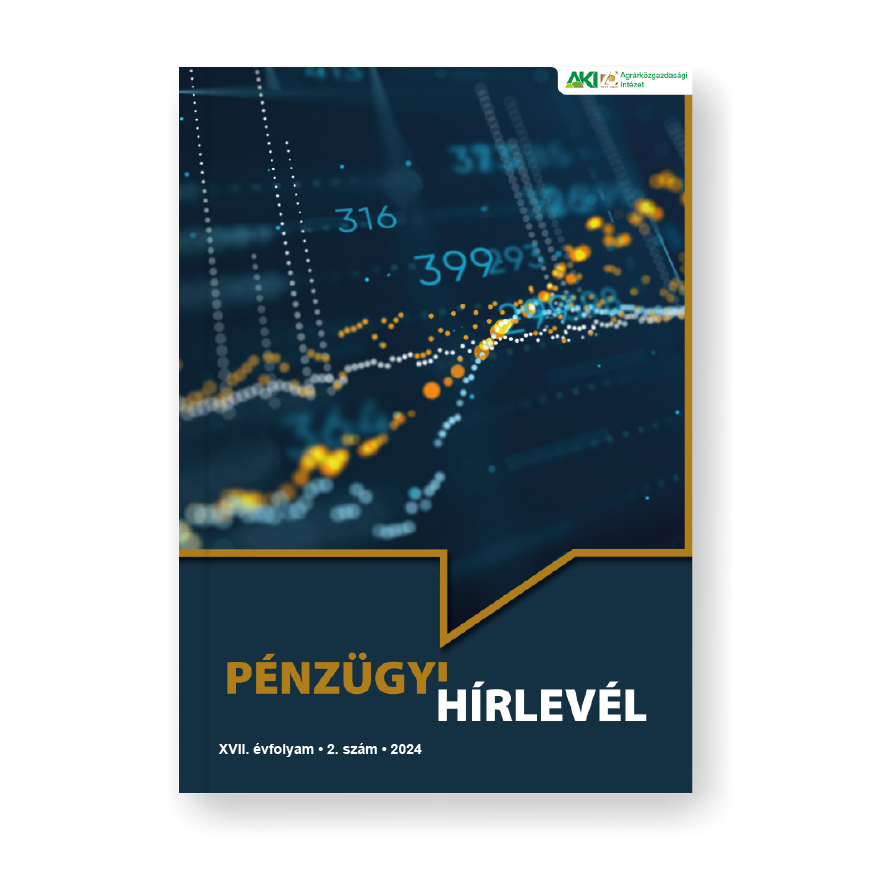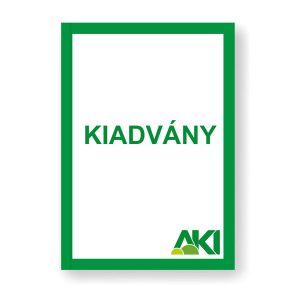Leírás
- A 2021–2022-es átmeneti évek után 2023. január 1-jén hatályba lépett a 2023–2027-es időszakra szóló közös agrárpolitika. Ezzel párhuzamosan tart még a 2014–2020-as ciklus lezárása.
- Agrár- és vidékfejlesztési támogatásokra 191,5 milliárd forintot fizettek ki március 31-ig. A folyósított támogatási összeg 61,0 százaléka (116,9 milliárd forint) európai uniós forrásból származott, 39,0 százalékát (74,7 milliárd forint) hazai költségvetésből fizették ki.
- Az agrár- és vidékfejlesztési támogatások között a Vidékfejlesztési Program kifizetései domináltak (49,8 százalék), melyek meghaladták a 95 milliárd forintot. A közvetlen támogatások a kifizetések több mint egyharmadát (40,3 százalék) képezték, 77,2 milliárd forint kifizetésére került sor március 31-ig. A nemzeti támogatásokra 16,4, a piaci és egyéb támogatásokra együttesen 2,6 milliárd forintot folyósítottak.
- Az egyes ágazatok támogatottságát vizsgálva elmondható, hogy a szántóföldi növénytermesztők kapták a támogatások több mint egyharmadát, míg az állattenyésztők a támogatások 23,0 százalékát használhatták fel, a kertészet részesedése pedig csupán 6,3 százalék volt.
- A nemzeti agrárkárenyhítési rendszer keretében (I. pillér) a 2023. évi időjárás okozta károk kompenzálására 2,8 milliárd forintot folyósítottak 2024-ben a jogosult termelők számára.
- A mezőgazdaság hitelállománya 8,2 százalékkal 1064,8 milliárd forintra emelkedett az előző év azonos időszakához képest. Ezen belül a kedvezményes hitelek aránya 68,9 százalékot, a piaci hitelek részesedése pedig 31,1 százalékot tett ki 2024. március 31-én.
- A mezőgazdaságban tevékenykedő egyéni gazdaságok hitelállománya 2,3 százalékkal 379,5 milliárd forintra nőtt. Az egyéni gazdaságok hitelei közül továbbra is a beruházási hitelek voltak túlsúlyban, állományuk 2,1 százalékkal 255,6 milliárd forintra bővült, és ez értékben a teljes hitelállomány közel 70 százalékát tette ki. A hitelek zöme a szántóföldi növénytermesztőket finanszírozta. A mezőgazdaságban tevékenykedő egyéni vállalkozások újonnan felvett hiteleinek összege 2,8 milliárd forinttal volt több az egy évvel korábbi értéknél.
- A mezőgazdasági társas vállalkozások hitelállománya 11,8 százalékkal 685,3 milliárd forintra emelkedett. A növekedés az éven túli hiteleknél jelentkezett, azon belül is a beruházási hitelek állománygyarapodása volt meghatározó, amely értékét tekintve meghaladta a hosszú lejáratú forgóeszközhitelekét. A hitelállományból legnagyobb mértékben az állattenyésztési ágazat részesedett. A mezőgazdasági társas vállalkozások újonnan felvett hiteleinek összege 1,8 milliárd forinttal volt több az egy évvel korábbi értéknél.
- A mezőgazdaság garantált hitelállománya dinamikusan nőtt. A lízingcégek szerződésszáma és a tőkekintlévőség összege is mérséklődött.
- Az élelmiszeripar hitelállománya – ellentétben a mezőgazdasággal – 0,3 százalékkal csökkent, ezáltal 742,5 milliárd forintra módosult 2024 első negyedévének végére. Az ágazat hitelállományában a kedvezményes hitelek aránya jóval kisebb volt, mint a mezőgazdaságban, 51,1 százalékot tett ki.
- Az egyéni vállalkozások hitelállománya 13,0 százalékkal volt kevesebb az előző év azonos időszaki értékénél, ezáltal 4,8 milliárd forintra mérséklődött, a társas vállalkozásoké 0,2 százalékkal 737,7 milliárd forintra csökkent. A csökkenés az éven belüli és az egyéb hiteleknél jelentkezett, de a rövid lejáratú hitelek részesedése 2024 első negyedévében a teljes hitelállományból így is 48,4 százalékot tett ki. A szóban forgó szegmens hitelállományának legnagyobb részét (28,1 százalékát) az ún. egyéb élelmiszeripar gyártása alágazatban tevékenykedő vállalkozások adták. Ezt követte 15,0 százalékos részaránnyal az egyéb gyümölcs-, zöldségfeldolgozás, -tartósítás, majd 8,7 százalékkal a baromfihús-feldolgozás, -tartósítás szakágazat.
- Az élelmiszeripari társas vállalkozások újonnan felvett hiteleinek összege 11,4 milliárd forinttal volt több az egy évvel korábbi értéknél. Az ágazat garantált hitelállománya 1,6 százalékkal csökkent 2024 első negyedévében.
- Az ágazati csődrátát emelkedő trend jellemezte, azonban mértéke mind a mezőgazdaságban (4,0 százalék), mind az élelmiszeriparban (6,0 százalék) alacsonyabb volt a nemzetgazdasági szintnél (7,6 százalék) a vizsgált időszak végén.
- A mezőgazdasági hitelportfólió minősége romlott 2024 első negyedévében.
- Az értékvesztéssel való fedezettség mindkét szektorban mérséklődött, a mezőgazdaságban 3,3 százalék, az élelmiszeriparban 5,9 százalék volt a vizsgált időszak végén. A mezőgazdaságban a folyószámlahitelek értékvesztéssel való fedezettsége csökkent a legnagyobb mértékben, míg az élelmiszeriparban a hiteltípus szerinti kategóriák többségénél nem volt érdemi változás.
- A nemteljesítő hitelek aránya (NPL-ráta) a mezőgazdaság minden alágazatában és minden hiteltípusnál javult (csökkent). Az élelmiszeripari alágazatok zömében, a malomipar és tejipar kivételével, szintén enyhe javulás volt megfigyelhető az előző év azonos időszakához képest. Az élelmiszeripari hitelek jellegénél nem történt érdemi változás az NPL-ráta értékében.
- A jegybanki alapkamat tovább csökkent, 8,3 százalék volt 2024. március 31-én.
A mezőgazdasági és élelmiszeripari hitelösszegekkel súlyozott állományi kamatlábak szintén alacsonyabbak voltak 2024 első negyedévében, mint az előző év azonos időszakában. A piaci forinthitelek kamatai jellemzően ereszkedtek, a piaci devizahitelek kamatai emelkedtek a hiteltípus szerinti kategóriákban, mindkét ágazatban a vizsgált időszakban. A mezőgazdasági alágazatok közül az állattenyésztés forinthitel kamatai jelentősen visszaestek. Az élelmiszeripari alágazatok éven túli forinthiteleinek kamatánál csökkenés és növekedés egyaránt előfordult.
- After the transition years 2021-2022, the Common Agricultural Policy for the period 2023-2027 entered into force on 1st of January 2023. At the same time, the closing of the 2014–2020 period is in progress.
- A total of HUF 191.5 billion was paid for agricultural and rural development subsidies by 31 March. 61.0 per cent (HUF 116.9 billion) of the subsidies came from European Union funds and 39.0 per cent (HUF 74.7 billion) was paid from domestic budget.
- Payments of the Rural Development Program dominated in agricultural and rural development payments (49.8 per cent), which exceeded the HUF 95 billion. Direct subsidies accounted more than a third (40.3 per cent) of payments, with HUF 77.2 billion paid by 31 March. Farmers received HUF 16.4 billion in national subsidies, and HUF 2.6 billion in market and other subsidies.
- Examining the support of each sector it can be considered that arable crop growers received more than a third of the subsidies, while livestock farmers could use 23.0 per cent of the support and the share of horticulture was only 6.3 per cent.
- Under the national agricultural compensation scheme (Pillar I), HUF 2.8 billion was paid to eligible farmers in 2024 to compensate for the damage caused by the weather in 2023.
- The amount of credit in agriculture increased by 8.2 per cent to HUF 1064.8 billion compared to the same quarter of the previous year. Within this the rate of subsidised loans was 68.9 per cent while the share of market loans was 31.1 per cent on March 31, 2024.
- The credit amount of the individual farms increased moderately, by 2.3 per cent to HUF 379.5 billion. Among the loans to individual farms, investment loans continued to predominate, with their stock growing by 2.1 per cent to HUF 255.6 billion, accounting for nearly 70 per cent of total loans. Most of the credit was used to finance arable crop growers. The value of new loans of individual farms in agriculture was HUF 2.8 billion higher than in the previous year.
- The credit amount of the agricultural enterprises increased by 11.8 per cent to HUF 685.3 billion. The increase was mainly for long-term loans, within this the growth of investment capital loans exceeded the growth of long-term working loans in terms of the value. The livestock sector accounted for the largest share of the credit. The amount of new loans taken out by agricultural enterprises was HUF 1.8 billion higher than in the previous year.
- The guaranteed loans of agriculture have grown dynamically. At the same time the contract number of leasing companies and their capital adequacy also decreased in the sector.
- In the food industry, the amount of loans – in contrast to agriculture –decreased by 0.3 per cent, to HUF 742.5 billion at the end of the first quarter of 2024. The share of subsidised loans (51.1 per cent) in the sector’s loan portfolio was much lower than in agriculture.
- The credit amount of the individual food companies decreased by 13.0 per cent to HUF 4.8 billion, and the credit amount of corporate enterprises also declined by 0.2 per cent to HUF 737.7 billion. In the food sector the decline was in short-term and other loans, but the share of short-term loans in total loans was even so 48.4 per cent in the first quarter of 2024. Biggest part (28.1 per cent) of the loans in the food industry were granted for food corporations operating in the so-called other food industry sector. This was followed by the other fruit and vegetable processing and preserving subsector with a share of 15.0 per cent, followed by the poultry meat processing and preserving area with 8.7 per cent.
- The value of new loans of corporate enterprises in the food industry was HUF 11.4 billion higher than in the previous year. The sector’s guaranteed loans decreased by 1.6 per cent in the first quarter of 2024.
- The sectoral rate of the risk of bankruptcy showed an upward trend in economy-wide level, in agriculture and in the food industry as well. Its’ value both in the agricultural sector (4.0 per cent) and in the food industry (6.0 per cent) were lower than the economy-wide level (7.6 per cent) at the end of the examined period.
- The quality of the agricultural loan portfolio deteriorated in the first quarter of 2024.
- Coverage of credit impairment charges fell in both sectors, to 3.3 per cent in the agriculture and 5.9 per cent in the food industry at the end of the period. In agriculture, impairment coverage of overdrafts decreased the most, while in the food industry there were no significant changes in the majority of loan type categories.
- The non-performing loan ratio (NPL ratio) improved (decreased) in all sub-sectors and regarding all (short- and long-term) loan types in agriculture. Most food sub-sectors,
except for the manufacture of grain mill products and manufacture of dairy products sub-industries, also showed a slight improvement compared to the same period of the last year. There was no significant change in the NPL ratio regarding all main types of loans in the food industry. - The base rate of the central bank was further reduced to 8.3 per cent by the end of March 2024. Interest rates weighted by the amount of loans to the agricultural and food sectors also decreased in the first quarter of 2024 compared to the same period of the previous year. Interest rates on market HUF loans typically declined, while interest rates on market foreign currency loans increased in case of the loan type categories, in both sectors, over the period under review. Among the agricultural sub-sectors, interest rates on HUF loans for livestock production decreased significantly. In the food sub-sectors, both decreases and increases in interest rates on long-term HUF loans were also observed.



 EN
EN

